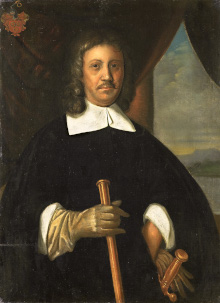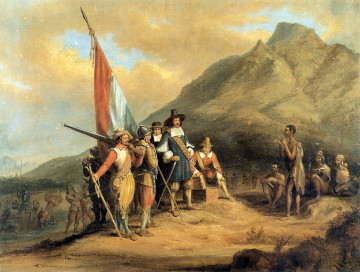1652 The arrival of the Dutch: The Cape a Dutch settlement
Jan van Riebeeck early Life and VOC Career

Johan Anthoniszoon "Jan" van Riebeeck was born on 21 April 1619 in Culemborg, Netherlands, into a family with modest means but ambition. His father, a surgeon, died when Jan was young, leaving him to forge his own path. In 1639, at age 20, he joined the Dutch East India Company (VOC), a powerhouse founded in 1602 that dominated global trade with Asia, rivaling the English East India Company. Starting as an assistant surgeon, he arrived in Batavia (modern Jakarta), the VOC’s East Indies headquarters, a humid, bustling port teeming with merchants and ships laden with spices, sugar, tobacco, alcohol, and timber. His early years exposed him to the company’s vast operations, which relied on a network of outposts to sustain its fleets. In 1643, he served at Dejima, a tiny artificial island off Nagasaki, Japan, where the VOC held a monopoly on Dutch trade with the isolated nation, exchanging European goods for silver and silk. By 1645, he rose to head the trading post in Tonkin (northern Vietnam), a key center for silk and ceramics in Indochina. However, the VOC’s notoriously low wages—often a source of discontent among its ranks—pushed van Riebeeck to engage in private trade, a risky but common sideline. Discovered in 1645 after profiting from deals outside company oversight, he was dismissed, fined, and ordered back to the Netherlands, a setback that redirected his career toward an unexpected legacy.
Vision and Arrival at the Cape
Van Riebeeck’s return journey in 1647 proved pivotal. Stopping at the Cape of Good Hope for 18 days to repair his ship, he assessed its potential as a resupply point for VOC crews suffering high mortality from scurvy and malnutrition on the grueling Europe-Asia route. He drafted a proposal, arguing the Cape’s mild climate and natural harbor could sustain a station to provision ships with fresh water, meat, and produce. His vision gained traction in 1649 when the VOC ship Haerlem wrecked near the Cape; its crew survived five months in a makeshift fort near Table Bay, proving the site’s viability. This incident spurred the Heeren XVII, the VOC’s governing board of 17 directors, to act. They commissioned Leendert Jansz, a junior officer, and Mathys Proot, a shipmaster, to evaluate the Cape, and their report praised its strategic value. On 24 December 1651, van Riebeeck departed Texel, Netherlands, commanding a fleet of three ships: the Dromedaris (his flagship), Reijger, and Goede Hoop, with two others, Walvis and Oliphant, joining later after storm delays that claimed 130 lives at sea. Arriving on 6 April 1652 with about 90 settlers—82 men and 8 women, including some families—the fleet anchored at Table Bay. The VOC’s trade empire, moving 40,200 passengers east on 205 ships and 13,000 back on 103 over the next decade, now depended on this outpost to cut losses and sustain its Asia-bound fleets.
Building the Cape Outpost
Jan van Riebeeck’s mandate from the Dutch East India Company (VOC) was straightforward: ensure food and shelter for the Cape station’s residents and the crews of passing ships. Arriving on 6 April 1652, he began work the next day, 7 April, meticulously recording the settlement’s early struggles and successes in journals that remain valuable historical records today. His immediate priority was the Fort de Goede Hoop, a pentagonal structure built from mud, clay, and timber, spanning 32 meters across with four bastions named after Dutch provinces—Holland, Zeeland, Utrecht, and Friesland. Completed in 1653 near modern-day Adderley Street in Cape Town, it served as both a home for settlers and a storage hub. To secure provisions, he planted gardens along the Liesbeek River and Table Mountain’s slopes, sowing wheat, barley, oats, and vegetables, and testing fruit trees like apples and citrus to fight scurvy among sailors. He also traded beads, copper wire, tobacco, and alcohol with the KhoiKhoi, the region’s nomadic pastoralists, to acquire cattle and sheep, though relations were often strained. The first winter, from May to August 1652, brought devastation—storms destroyed crops, killed livestock, and claimed 19 settlers, shrinking his initial crew of about 90. Despite these setbacks, van Riebeeck pressed on, harnessing the fertile volcanic soil on Table Mountain’s eastern slopes for future yields.
Early Khoi Khoi Trade Ties

The early encounters between Jan van Riebeeck and the Khoekhoe people at the Cape of Good Hope in 1652, as recorded in the Daghregister, show the beginnings of a unique trading relationship. On April 7, 1652, the Khoekhoe, led by Autshumato (known as "Harry"), approached the Dutch with livestock, eager to trade cattle for beads, copper wire, and tobacco. Their interest in European goods wasn’t new; for centuries, the Khoekhoe had been exchanging livestock with passing ships, acquiring iron and other goods in return. Autshumato, or "Harry," played a pivotal role in facilitating these early exchanges. His ability to communicate with the Dutch was a significant advantage. Through years of interacting with European vessels, the Khoekhoe had gained experience in maritime trade. Autshumato, in particular, learned English from British sailors who had frequented the Cape, which made him an invaluable intermediary. His knowledge of European goods and trade practices allowed him to negotiate skillfully on behalf of his people. Throughout the year, the Dutch and Khoekhoe met regularly, with the Khoekhoe bringing cattle and sheep for trade. The Dutch settlers, eager for fresh provisions like meat and hides, gladly exchanged goods like beads, tobacco and alcohol. These exchanges were often smooth, but there were occasional tensions, Van Riebeeck wrote, “A soldier stole a sheep, causing unrest, but Harry settled it,” after which they traded more cattle for tobacco and copper wire. The Daghregister mentions their frequent visits near the camp, observing the Dutch unloading ships and setting up, their curiosity clear in their proximity. Despite the theft, they remained open to trade, providing livestock in exchange for goods.
Growth and the Vryburger Initiative
After several challenging years, Jan van Riebeeck made steady progress toward establishing a functional refreshment station for the Dutch East India Company (VOC). By the mid-1650s, he had overseen the construction of a basic hospital with 200-300 beds to treat sick sailors and settlers, cultivated a large garden yielding diverse crops like vegetables and cereals, and introduced animals from Java and Europe—horses, pigs, sheep, dogs, rabbits, and poultry—to diversify resources. Despite these advances, he realized production couldn’t fully support the outpost or meet the VOC fleet’s growing demand for grains, such as wheat and barley, critical for sustaining crews on long voyages. Under pressure from his superiors to cut costs, van Riebeeck proposed a strategic shift: introducing a "Vryburger" (free citizen farmer) population. In a presentation to the Heeren XVII, the VOC’s board of directors, he argued that Vryburgers could boost supplies at lower expense, leveraging their labor to ease the company’s burden. On 21 February 1657, nine VOC employees received "vrybriewe" (letters of release), freeing them from service to begin farming on small plots in Rondebosch. This marked a turning point, expanding the Cape’s capacity beyond its early struggles.
The Vryburger System and VOC Control
The Vryburger plan, while practical in intent, revealed a harsh system of governance under the Dutch East India Company (VOC). Van Riebeeck implemented a controlled market where free trade was banned—Vryburgers, granted 13.3-morgen plots (about 11.4 hectares) along the Liesbeek River, were forbidden from selling goods independently, even to the KhoiKhoi, and required to sell all produce to the VOC at fixed, low prices. The VOC morphed from employer into the sole government and marketplace, leaving Vryburgers without political rights and firmly under its jurisdiction. This mercantile framework relied on monopolies and manipulation, with the VOC as the only buyer setting prices to its advantage, making financial independence elusive for farmers. It further entrenched control by awarding "pachts"—monopoly contracts via tenders—for nearly all produce, from grain to livestock. Wealthy farmers secured these rights, fostering corruption as they colluded with VOC officials, while others turned to smuggling to evade restrictions. Most early Vryburgers, former soldiers and sailors who arrived at the Cape by chance, entered this system ill-equipped, their small plots fueling a settlement that enriched the VOC.
For a complete list of sources, see the References page.